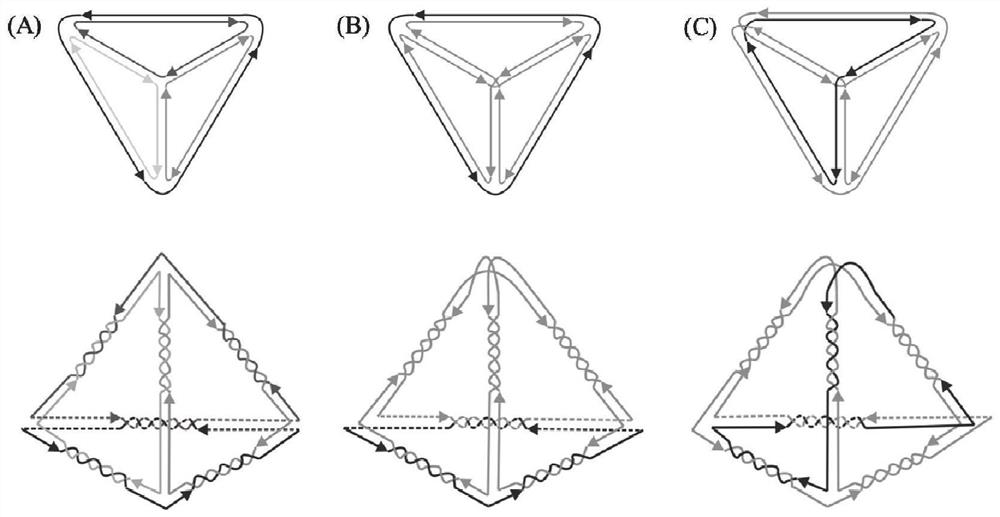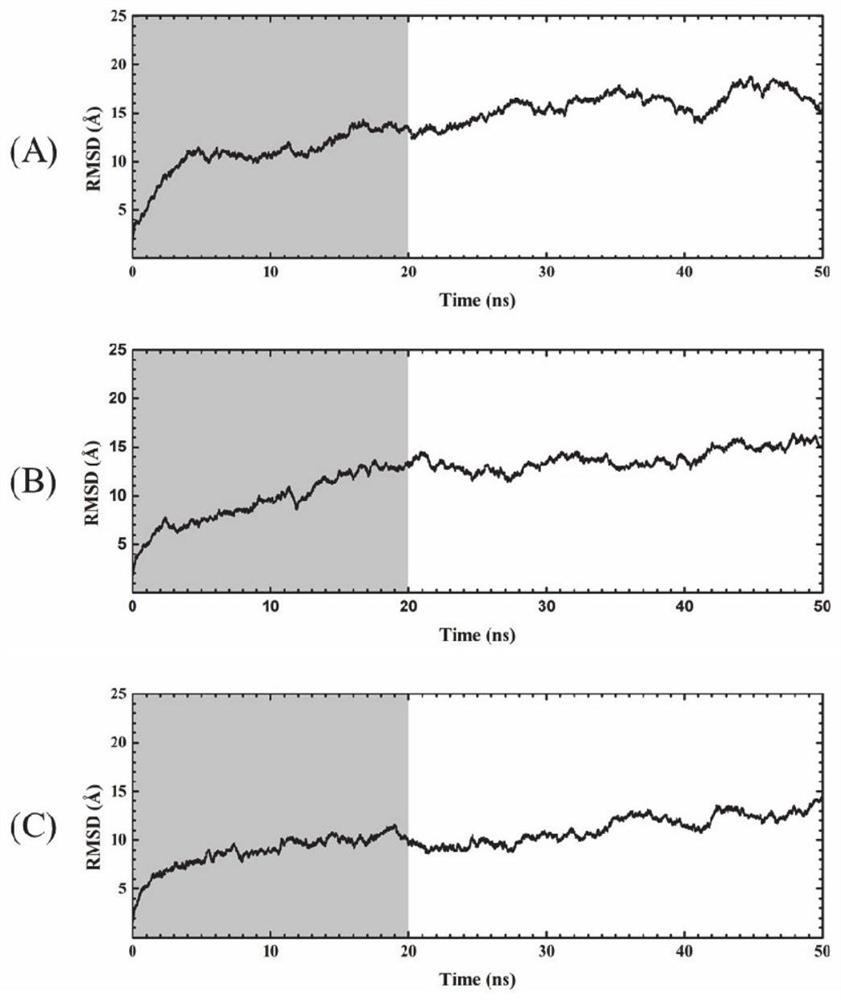A simulation analysis method of dna polyhedron with special branch number
A technology of simulation analysis and polyhedron, which is applied in the field of simulation analysis of DNA polyhedron, can solve the problems of inability to judge the influence of DNA polyhedron properties, lack of research on the structure of DNA polyhedron, etc., and achieve the effect of low cost
- Summary
- Abstract
- Description
- Claims
- Application Information
AI Technical Summary
Problems solved by technology
Method used
Image
Examples
Embodiment 1
[0068] (1) First, draw a four-branched DNA tetrahedral chain loop diagram. The number of branches of the DNA tetrahedron is set to 4, the number of crossings on each edge is set to 6, the length of the double helix edge is set to 31nt, and the length of the linker at the vertex is set to 3T. The link diagram of the polyhedral structure of DNA is shown in figure 1 As shown, the whole structure consists of 4 DNA single strands, each strand is 3 tetrahedral side lengths, and the DNA tetrahedron is named 4s.
[0069] (2) Use the software uniquimer3D to design the sequence of the DNA polyhedron. The sequence of the DNA polyhedron is as follows, where the underlined part represents the linker:
[0070] strand 1:
[0071] AAACTACTCCTCGAAGTGATTTGTACCGTCT TTT GATAGGGCGGGACCCGG
[0072] GATAGCATATGGGT TTT TGCCCGGATCGAGACCCCTCAATTCGGGAGG
[0073] strand 2:
[0074] ACCCATATGCTATCCCGGGGTCCCGCCCTATC TTT ATTTGCGTGATCGCATCACTACCAGACGGAC TTT TAAAAGGGGAATCCCTGCCACGTGAATGCGG
[00...
Embodiment 2
[0087] (1) First, draw a bi-branched DNA tetrahedral chain loop diagram. The number of branches of the DNA tetrahedron is set to 2, the number of crossings on each edge is set to 6, the length of the double helix edge is set to 31nt, and the length of the linker at the vertex is set to 3T. The link diagram of the polyhedral structure of DNA is shown in figure 1 As shown, the whole structure consists of 2 DNA single strands, one of which is 3 tetrahedral sides in length, and the other is 9 tetrahedral sides in length, and the DNA tetrahedron is named 2s1.
[0088] (2) Use the software uniquimer3D to design the sequence of the DNA polyhedron. The sequence of the DNA polyhedron is as follows, where the underlined part represents the linker:
[0089] strand 1:
[0090] ATCGTCTATAGTAAGTTTTTCCTAACGCAGG TTT TGTTTTCGCGTTACTTTATAGCGGATTTTCA TTT TTGGATCAAATATGAGTAGGTCACGTATCTA TTT TCGGATCCTAGGCTCAGGATCTGGGTATCCA TTT TAGCACATTCAATCTCCGTTCAGGGGCTCGG TTT TGAAAATCCGCTATAAAGTAACG...
Embodiment 3
[0101] (1) First, draw a bi-branched DNA tetrahedral chain loop diagram. The number of branches of the DNA tetrahedron is set to 2, the number of crossings on each edge is set to 6, the length of the double helix edge is set to 31nt, and the length of the linker at the vertex is set to 3T. The link diagram of the polyhedral structure of DNA is shown in figure 1 As shown, the whole structure is composed of 2 DNA single strands, one of which is 4 tetrahedral sides in length, and the other is 8 tetrahedral sides in length, and the DNA tetrahedron is named 2s2.
[0102] (2) Use the software uniquimer3D to design the sequence of the DNA polyhedron. The sequence of the DNA polyhedron is as follows, where the underlined part represents the linker:
[0103] strand 1:
[0104] GGTCGCTGTCGAAAGGCAGTTTCCTAGCAAT TTT TTCGCACGGTGGAGAGTCCGTCTTAACCGCC TTT TGCCGTCCGACTGGATGTTCAGTTCCTCAAA TTT GCTGTGTAGGTCTGACGCAAAGATCGTACAT TTT ATTGCTAGGAAACTGCCTTTCGACAGCGACC TTT GGGTTTTGCCCTTGTTCAGG...
PUM
 Login to View More
Login to View More Abstract
Description
Claims
Application Information
 Login to View More
Login to View More - R&D
- Intellectual Property
- Life Sciences
- Materials
- Tech Scout
- Unparalleled Data Quality
- Higher Quality Content
- 60% Fewer Hallucinations
Browse by: Latest US Patents, China's latest patents, Technical Efficacy Thesaurus, Application Domain, Technology Topic, Popular Technical Reports.
© 2025 PatSnap. All rights reserved.Legal|Privacy policy|Modern Slavery Act Transparency Statement|Sitemap|About US| Contact US: help@patsnap.com



